new posts in all blogs
Viewing: Blog Posts Tagged with: Galicia, Most Recent at Top [Help]
Results 1 - 11 of 11
How to use this Page
You are viewing the most recent posts tagged with the words: Galicia in the JacketFlap blog reader. What is a tag? Think of a tag as a keyword or category label. Tags can both help you find posts on JacketFlap.com as well as provide an easy way for you to "remember" and classify posts for later recall. Try adding a tag yourself by clicking "Add a tag" below a post's header. Scroll down through the list of Recent Posts in the left column and click on a post title that sounds interesting. You can view all posts from a specific blog by clicking the Blog name in the right column, or you can click a 'More Posts from this Blog' link in any individual post.
 |
Beautiful weather for driving along
scenic roads from village to village. |
 |
We love going through these small
villages. |
We arrived in Galicia exactly a week today, in the evening, and have fallen under its spell, as we always do. I'm behind in everything, including a book review I've been promising of an utterly wonderful book, Nancy Herman's,
All We Left Behind. Be patient, folks, it's coming.
But it has felt great to just relax after the hectic days leading up to our trip -- the bathroom remodel, putting the house back together before our trip, the book signing at Time Tested Books (a delightful evening), and setting up other book signings after we return. When we got to Galicia, we just gave into the trance of taking long walks and long drives for photo shoots, visiting friends and neighbors. We've been blessed with beautiful sunny days, although it's been a little windy at times, and at times there has been the usual sprinkle of rain. And at this time of year, the countryside abounds with wild broom, whole fields of it.
 |
| Add caption |
Brilliant yellow sprays of it, everywhere. And on the roadsides, buttercups, Queen Anne's lace, small, magenta thistles, purple foxglove, fields of white daisies, tiny blue forget-me-nots, and rose-colored alfalfa, and the all pervasive greenery.
Cuckoos call, and you see the flash of black and white wings of the magpies. And in Tuiriz, near the church, two stork nests rise atop poles that seem to be their designated area. Originally they built their next on the church steeple. Meanwhile, nearby, around the corner from our house, Eva's chickens peck the corn she gives them that is responsible for the brilliant gold of their eggs.
Still, around all the tranquility, this is a working vacation for me, and I will be back to work on my cozy mystery re-write starting this afternoon, and a book review will soon follow this post.
Also, please check out Rosi Hollinbeck's interview with me, review of my book,
Imogene and the Case of the Missing Pearls, and a giveaway, on her blog,
THE WRITE STUFF. In addition to interviews and book reviews of children's books, Rosi provides wonderful links to other blogs sites with information on the writing process, writing career issues, contests, etc. She offers a banquet of information at her site. Go
HERE to see what I mean.
But for now, a second cup of coffee, and one last view out the galería window before I get to work.


By:
Elizabeth Varadan,
on 10/6/2014
Blog:
Elizabeth Varadan's Fourth Wish
(
Login to Add to MyJacketFlap)
JacketFlap tags:
pulpo,
olive oil,
Galicia,
Monforte,
feria,
fresh bread,
house wine,
pimiento.,
Spain,
Add a tag
 |
A plate full of pulpo. You eat it with
toothpicks, bite by bite. Then you
break off chunks of crusty bread and
sop up the spiced olive oil. Yum! |
 |
Our wonderful neighbor,
Miguel |
Today, despite the fact that it's nearly two weeks since our return from Portugal, I had every intention of writing a post about
Fado, the Portuguese art form of song we both love so much, to be followed by a later post mid-week about the photography festival we attended when we were in Braga Portugal.
But then our neighbor across the lane from us treated us to
pulpo at the
feria in Monforte, 20 minutes away from our village, and, as usual, we were enthusiastically swept away. (This is the neighbor who keeps sheep, and sometimes in the mornings, we awaken to their soft bleating.) Off we went, my Fado post tabled for another day.
Pulpo is octupus, boiled, cut in small pieces, drizzled with olive oil and sprinkled with salt and
pimiento - which in this area, means hot red pepper. All of our neighbors simply love
pulpo, and their enthusiasm has been contagious. Though vegetarians, we do eat
pescados and
mariscos (fish and seafood), but octopus was a new experience for us. When done right, meaning boiled long enough, it comes out moist and tender and just delicious. It is served at long tables, in special buildings at all the fair grounds, and one of the servers comes around with a bottle of the house red wine and a loaf of fresh bread to go with it.
 |
The woman boiling this pulpo
is the neighbor of a woman in
Turiz, Melucha, whom we met
years ago when she was walking
her cows down the road to graze.
The people in these neighboring
villages all know each other, so
Miguel was able to tell us this. |
 |
Rajan, adding his touch. We
actually see this woman and
another (who is distantly re-
lated to Miguel), at ferias in
the other villages, since the
market days in the villages
fall on different days. |
 |
One of the long tables set up for this
event. For those who don't like pulpo,
there is also barbequed beef or sausage. |
 |
Despite the note about beef, most of
these people are eating pulpo,
always the favorite. |
 |
| Good to the last drop. |
 |
| Definitely a satisfied customer. |
Feria is "fair" or market day, and in the mornings, nearly everything is sold at a
feria: shoes, blouses, scarves, belts, beaded jewelry, plants, fruit, all kinds of produce, honey, bread loaves of all types, utensils for making wine, utensils for making the home-made brandy so popular here,
aguardiente. One shot of that will blow your head off, but most people around here confine it to a little shot in their coffee when they do decide to have it. There is also a special drink they make, using
aguardiente, called
quemada, with orange peel, apple peel, coffee beans, and sugar, blogged about, before
, HERE. (Scroll down to the very bottom of it, and you'll learn about the drink and the history behind it, as well as seeing the clay vessel they make it in and the clay cups they serve it in; the set is also called a
quemada, and it is also sold at the
ferias.)
While we were there, a gypsy playing an accordion came in and played some melodies that were so familiar to the crowd, some sang along. It was an absolutely charming touch (and he gained a few coins for that) but, alas, I didn't take pictures. A memorable lunch, for sure.
How about you? Have you ever eaten octopus? Have you ever found yourself eating a dish you thought you never would?

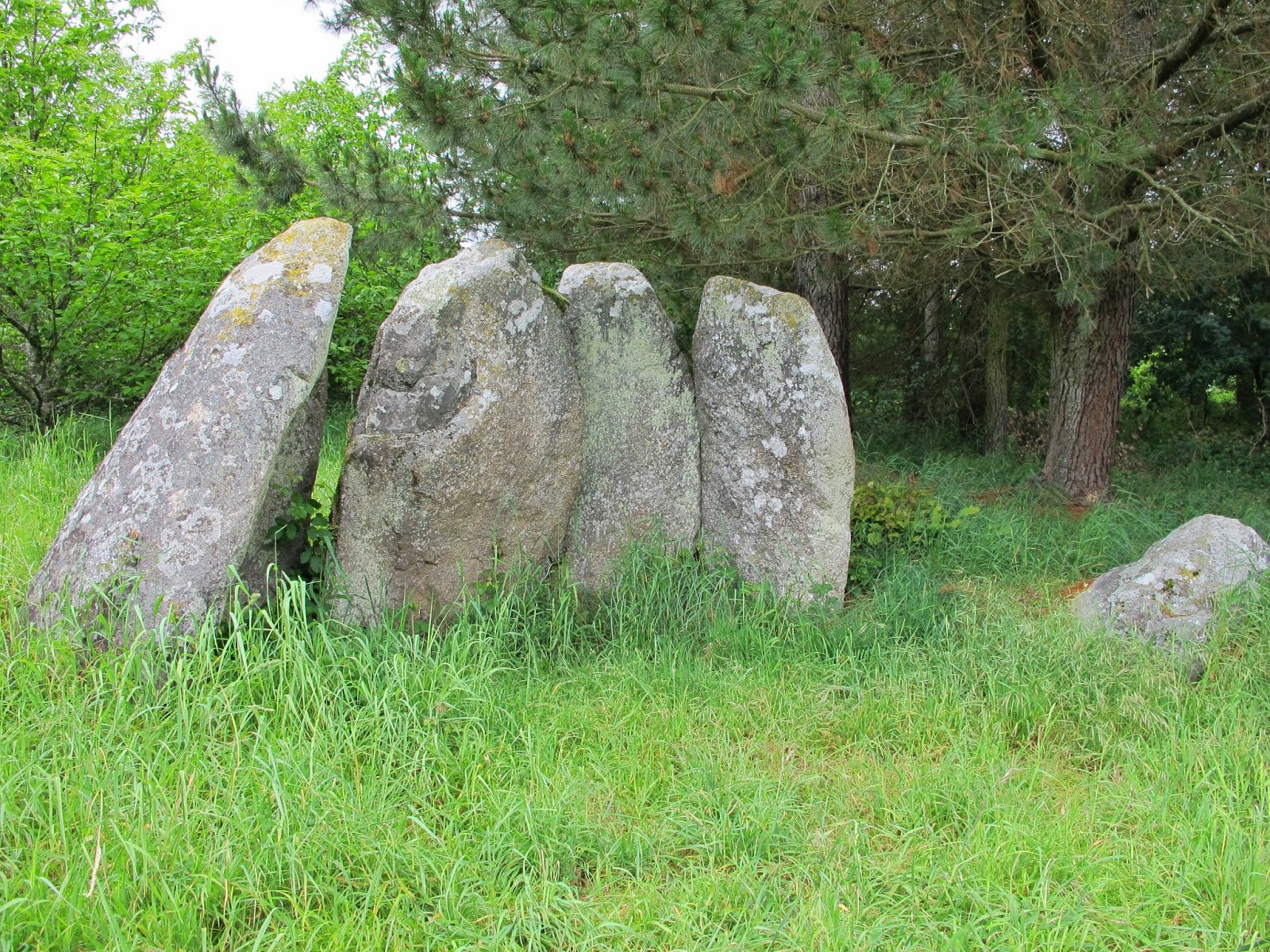 |
| Five big rocks that may surprise you. |
Here it stands, a collection four immense standing stones, the fifth one fallen to the side, tucked back in the far end of a field nearly hidden by trees, easily missed, if you didn't know about it. We knew about it because good friends in Galicia, Craig and Melanie, told us about it.
 |
Craig, Melanie, and their
loveable dog, Slawit |
A brief introduction here: Craig and Melanie are good friends in Galicia who sold us our house in Trasulfe.
They are from England, but they have lived in Galicia for about ten years, and Craig has written a book about their adventures. He also has a blog, and he wrote nice a post about the dolmen
HERE . Enjoyment of wine in Spain is contagious, and he has started growing his own vines and making his own wine (which is pretty good; we get to sample it whenever we go to Galicia. ) In addition, they have restored another home, and this one they rent out. (You can learn more about it at his blog site.)
So, back to the dolmen. And what is a dolmen? you might ask? Wikipedia gives a pretty good explanation of dolmens and where they can be found,
HERE . Basically a dolmen is considered a megalithic tomb. Usually it has
a flat capstone on top of the standing stones. Rajan and I wonder if the stone in the picture above that is off to the right is the original capstone for this dolmen. Originally dolmens were covered up with earth mounds, and 5,000 to 6,000 years of erosion have uncovered them.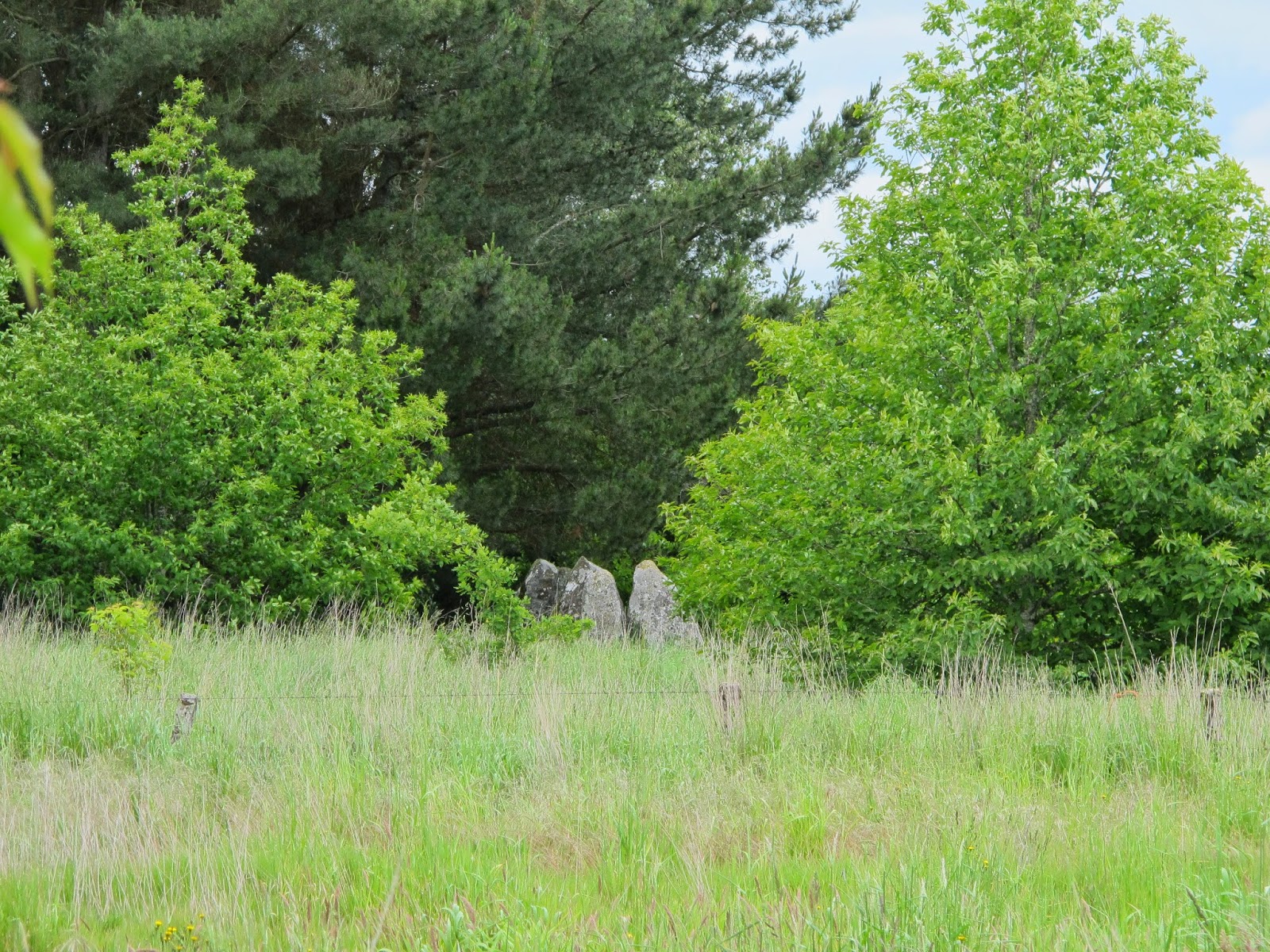 |
Even with enlarged photo, it's hard to tell. After all, the
trees are pretty tall, and it's hard to tell hear just how tall. |
Even with Craig and Melanie's good directions and the picture on Craig's blog post, we had to look for it. Despite signs, from a distance, it's hard to appreciate the size.
This should give you a better idea:
 |
| How on earth did they prop these stones up? |
Anyone who know me knows I have a thing about old buildings. I love to touch old man-made structures, whether 12th century walls or Roman era bridges, whether in England or Spain. But our British friends all find this somewhat amusing. After all, they remind me, they grew up surrounded by historic buildings and Roman bridges. It's no big deal to them. But I always have to touch these old edifices that, I feel, bear still the mystical aura of humans touching them long ago.
So, you can imagine how enthralled I was to touch something that humans touched maybe 5,000 or 6,000 years ago.
 |
| Yup! Pretttty impressed. And pretty happy, too. |
On another note, this week I had two pieces of pleasant news:
1. A blog friend, Julian Hones, gave me the "Inspiring Blog" award on her great site,
My Writing Life . Julia is an editor of a magazine and writes poetry and short fiction. The blog carries some "pass it on and give information" duties that will have to wait for another post, but I was certainly pleased to get it. Thank you, Julia.
2. I made this announcement on Facebook, but for those of my blog friends who are not on FB, My Flash Fiction, "Persephone," is in the current issue of Fiction Attic Press and will also be in the
Flash in the Attic anthology.
You can read it HERE: If you have time to read it, I'd love your feedback.
Meanwhile, how do you feel about old buildings? Do have that irresistible urge to touch them and imagine who touched them so many years ago?

By:
Elizabeth Varadan,
on 6/22/2014
Blog:
Elizabeth Varadan's Fourth Wish
(
Login to Add to MyJacketFlap)
JacketFlap tags:
live music,
raptors,
Galicia,
Escairon,
fiestas,
medieval fair,
bar-restaurant,
casa rural,
historical re-enactments,
Monforte de Lemos,
Add a tag
We have been traveling, and I started this post when we were still in England, visiting family. (Post about that to follow when I finish the posts about Spain.k) We got back late last night (actually early this morning), but I had promised to get back to two events in the earlier part of our Galicia visit, and here they are:
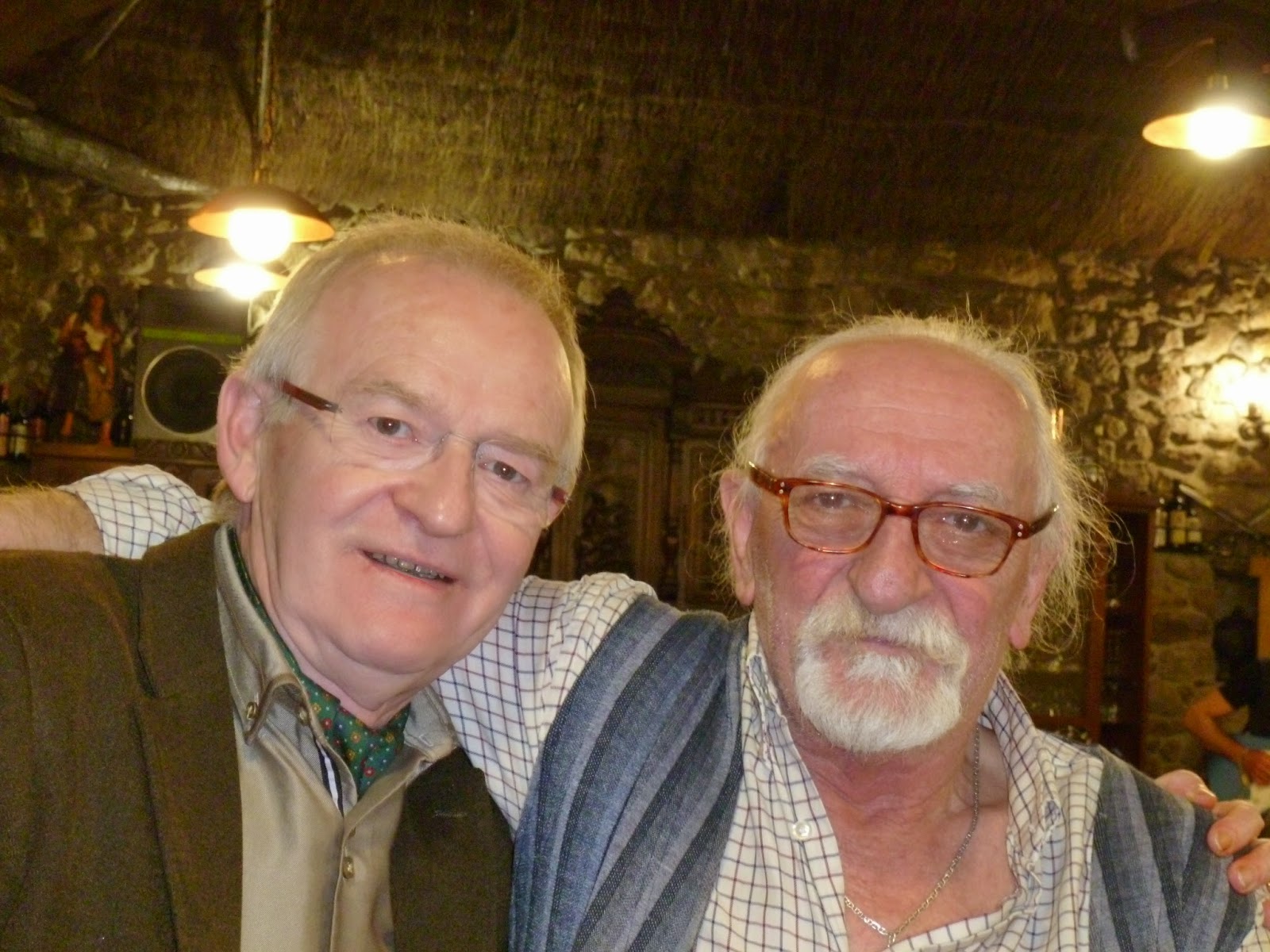 |
| David and Pepe |
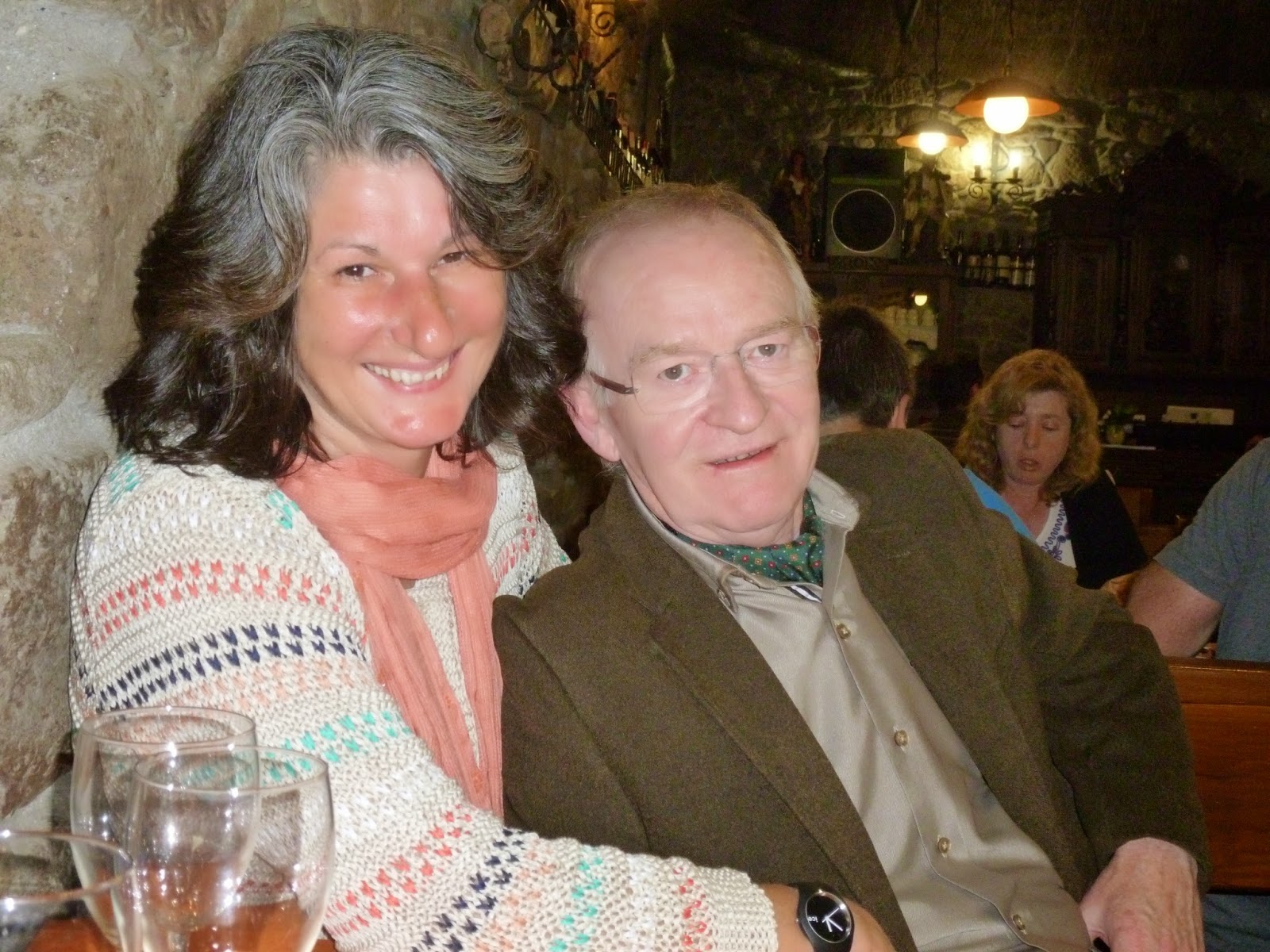 |
| David and Terri |
FIRST: The Friday after our arrival -- April 11th -- We went with friends Terri and David to what is known as a "casa rural," but also includes a restaurant/bar and week-end entertainment. The name is Torre Vilariño, and it is co-owned by a cool hombre named Pepe. Alas, I don't know his full name, but here he is with David. And
here is the website, which has lovely pictures of the rooms where one can stay, as well as the restaurant and patio.
On this particular Friday, two main musicians were playing. We had dinner first (around 9:30), and the music started around 11:00 p.m. One of the musicians sang, both of them played, and they went through a whole gamut of popular songs from the 80s -- in English. They were really good. Here are a few pictures:
 |
| The main duo. |
 |
| The singer. |
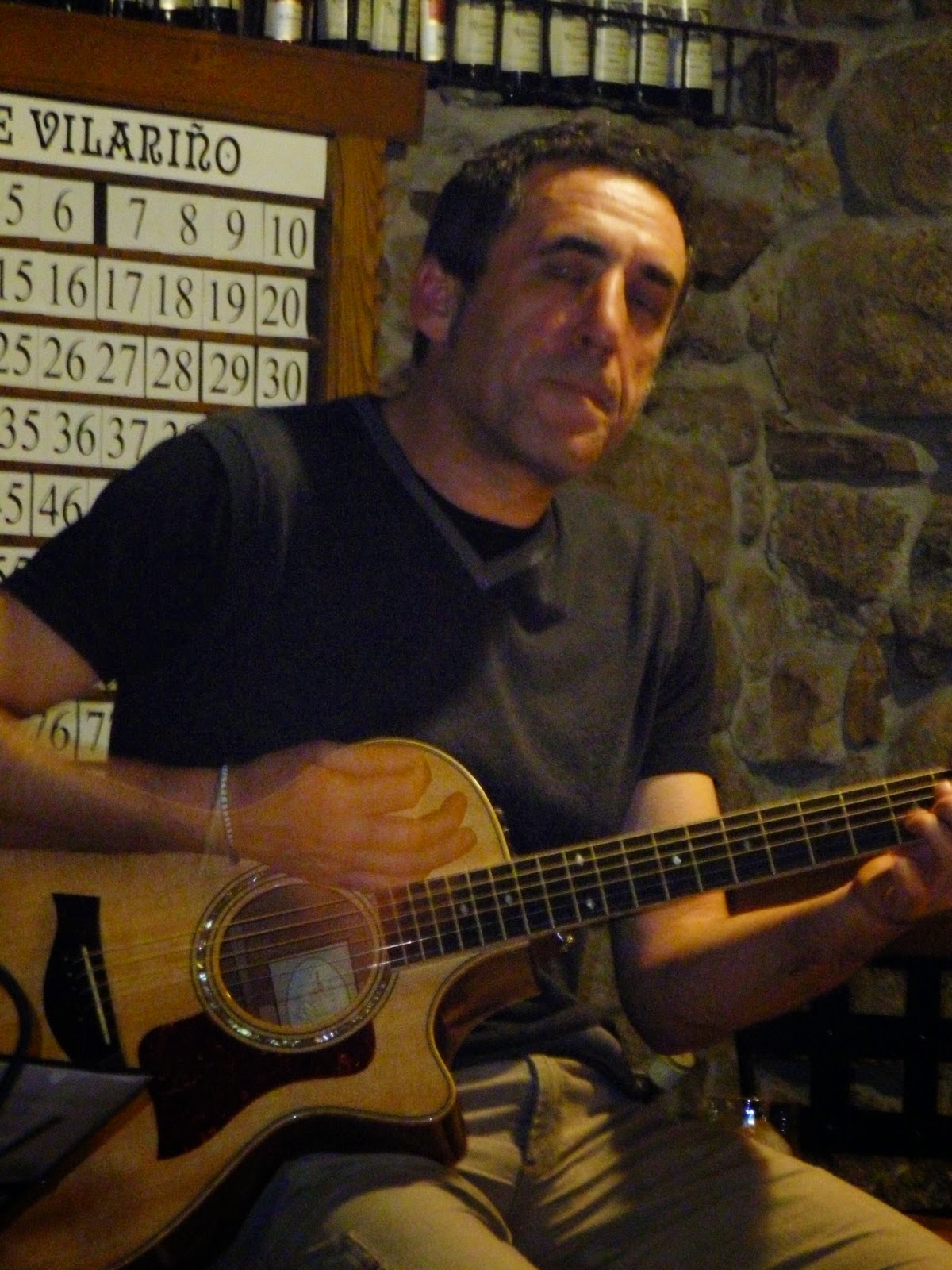 |
| Hearfelt guitar work. |
Occasionally a third musician joined them and sang along. They had a good sound! (I wish I had gotten the name of the group.)
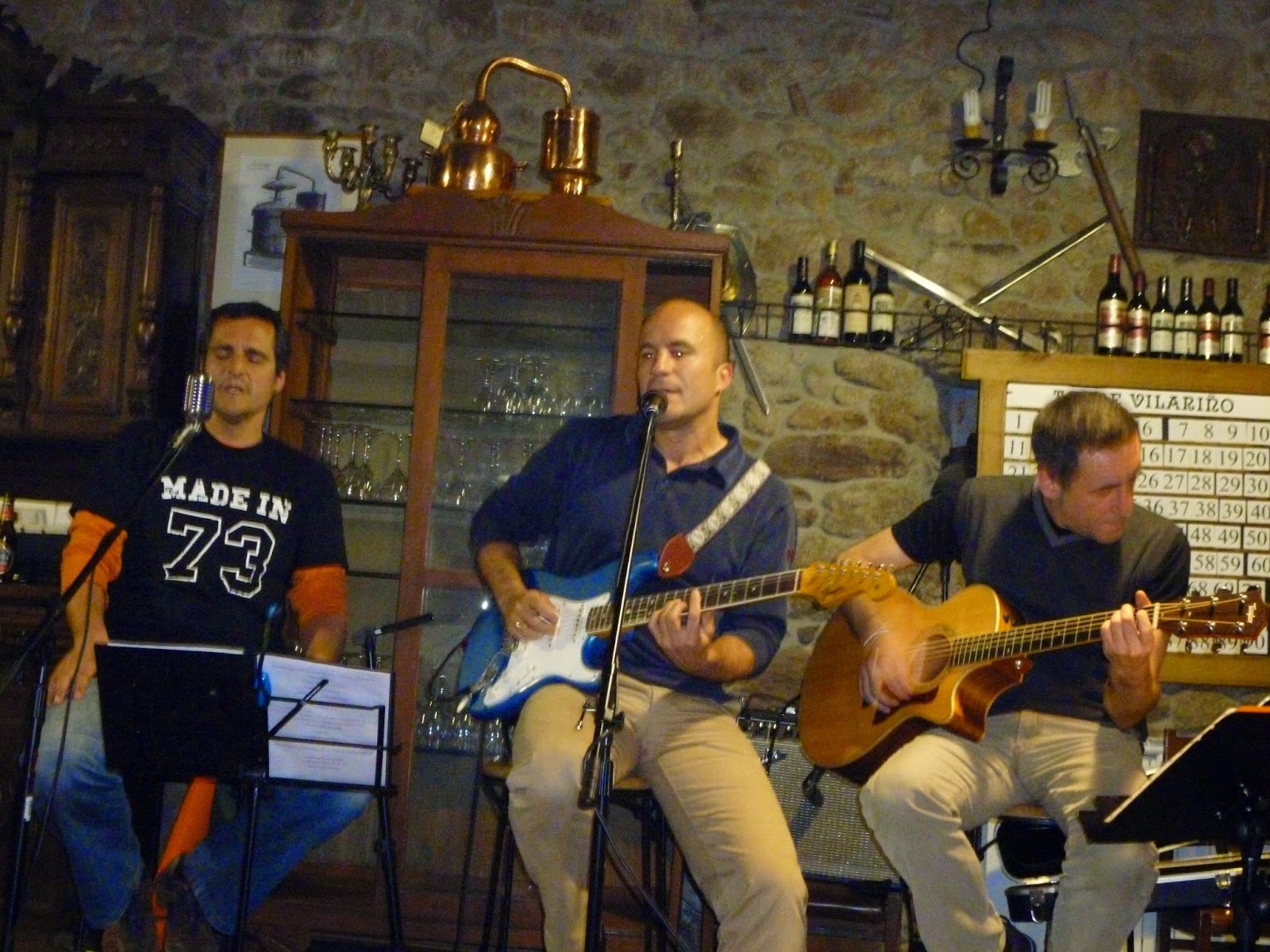 |
| Jamming! |
 |
The servers thought they were
pretty good, too. Singing along
with great gusto! |
 |
| Susana, server extraordinaire! |
The SECOND event was the
Fiesta Medieval that takes place each year at the end of
Semana Santa (Holy week). It used to only take place on Saturday, but now it has grown to include the entire week-end. We went both days. We love this fiesta, many locals dress up in costume, and small skits and re-enactments are put on in main streets and plazas. I'll let the pictures speak for themselves:
 |
Processions . . . this is a special
galician bagpipe called a gaeto. |
 |
| A medieval damsel . . . |
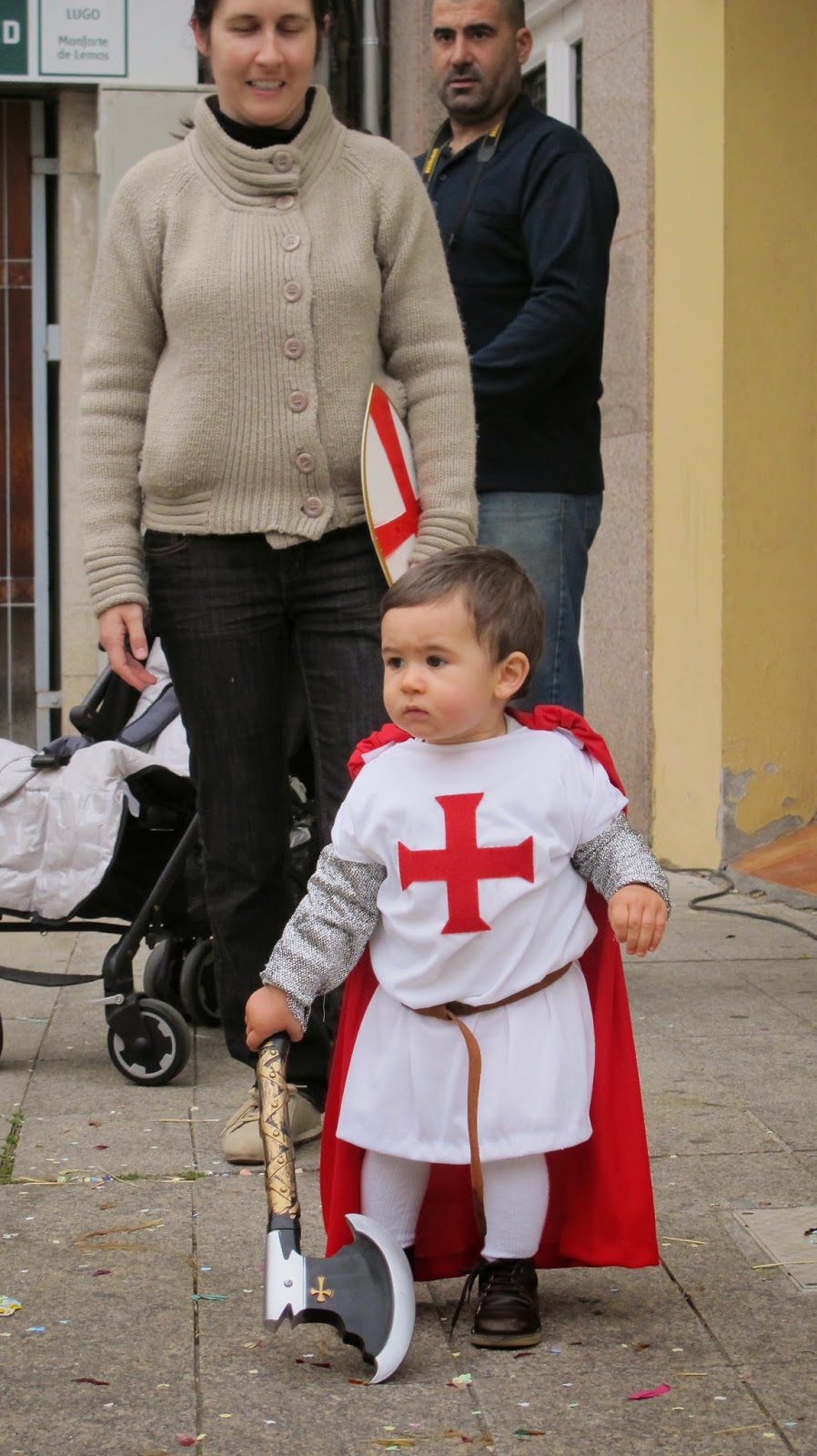 |
| A verrry young knight Templar! |
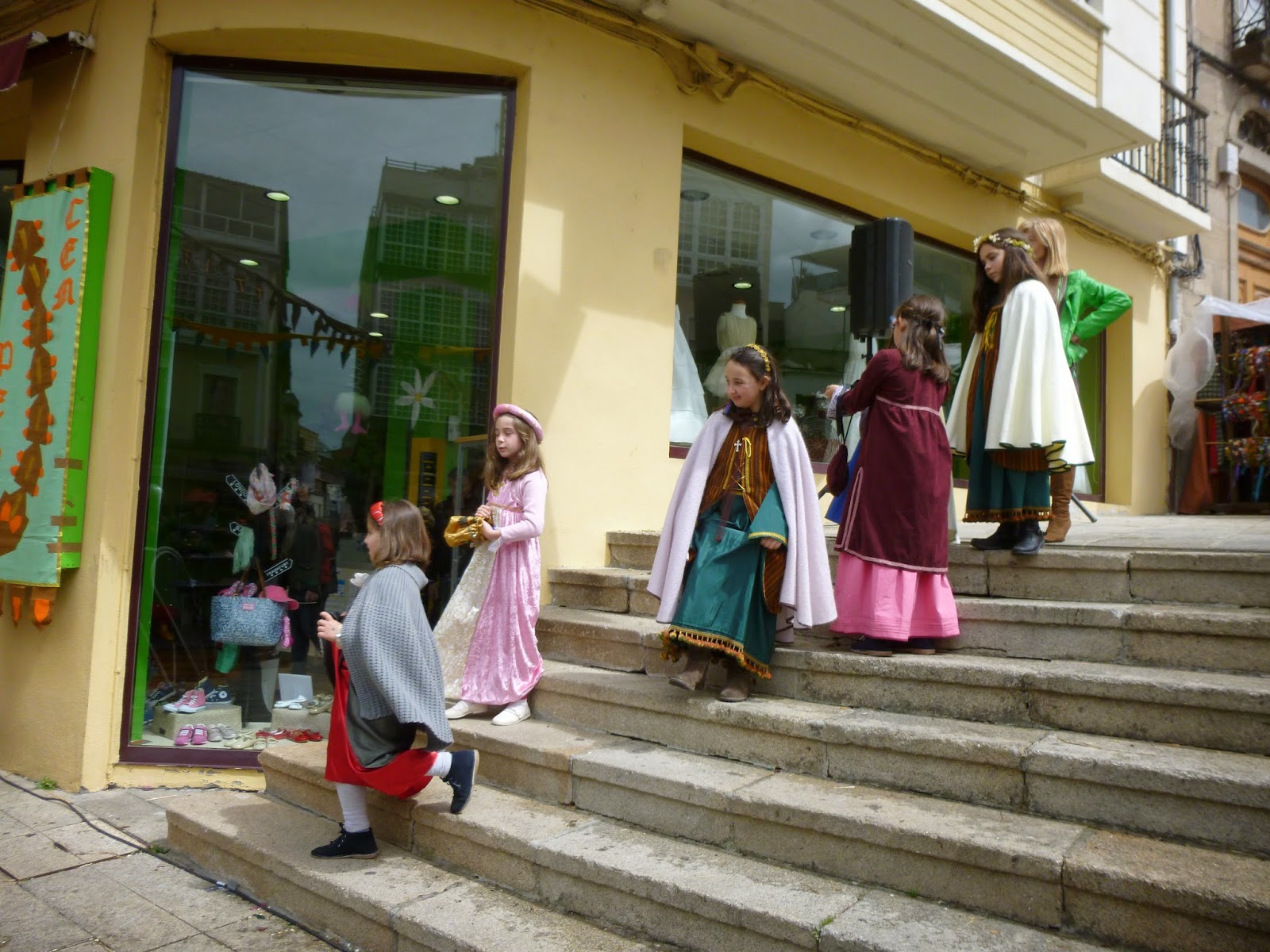 |
| From one of the plazas. |
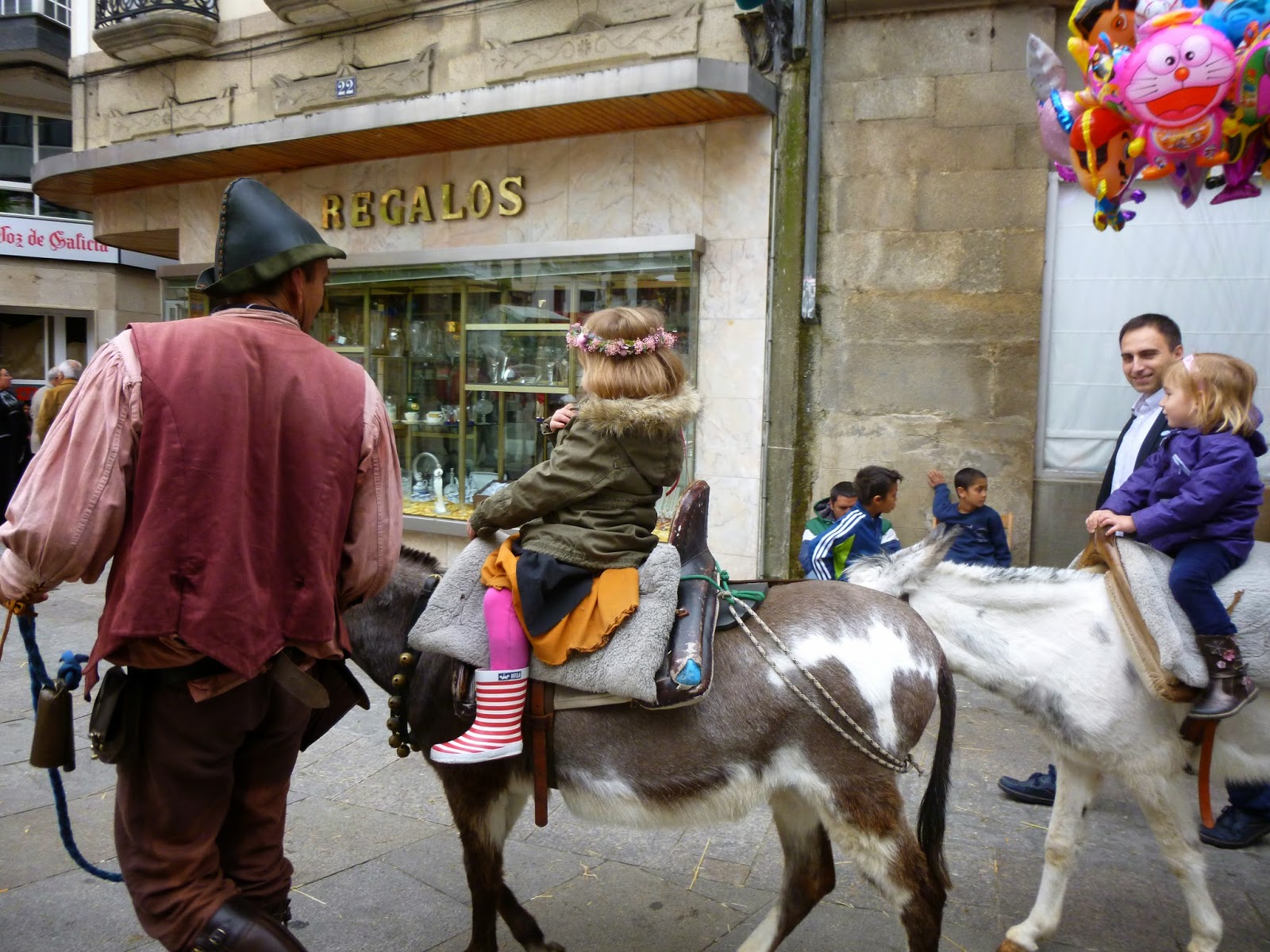 |
| And the little ones on burros! |
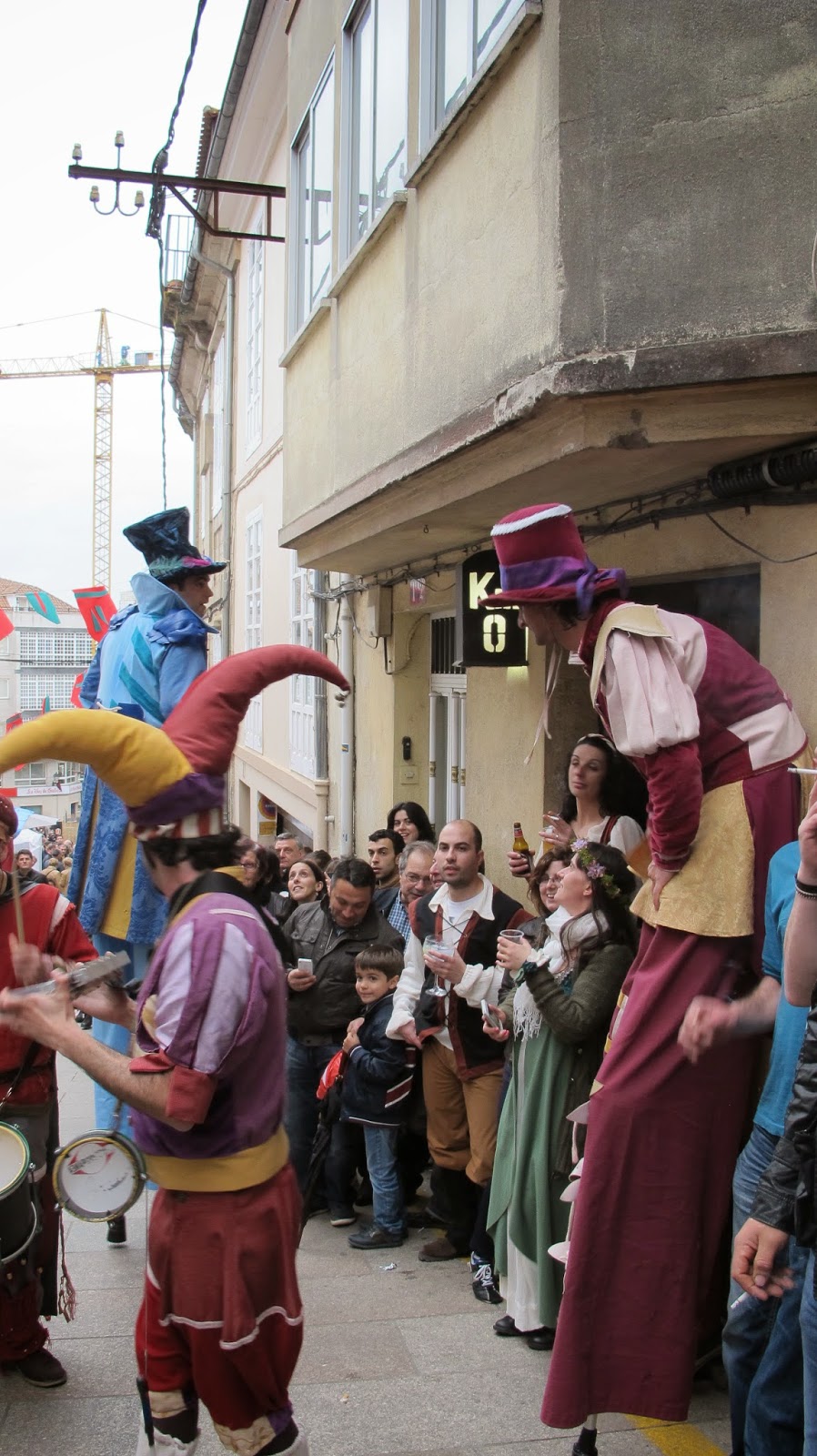 |
| Entertainers on stilts. |
 |
I don't know how
they do it! |
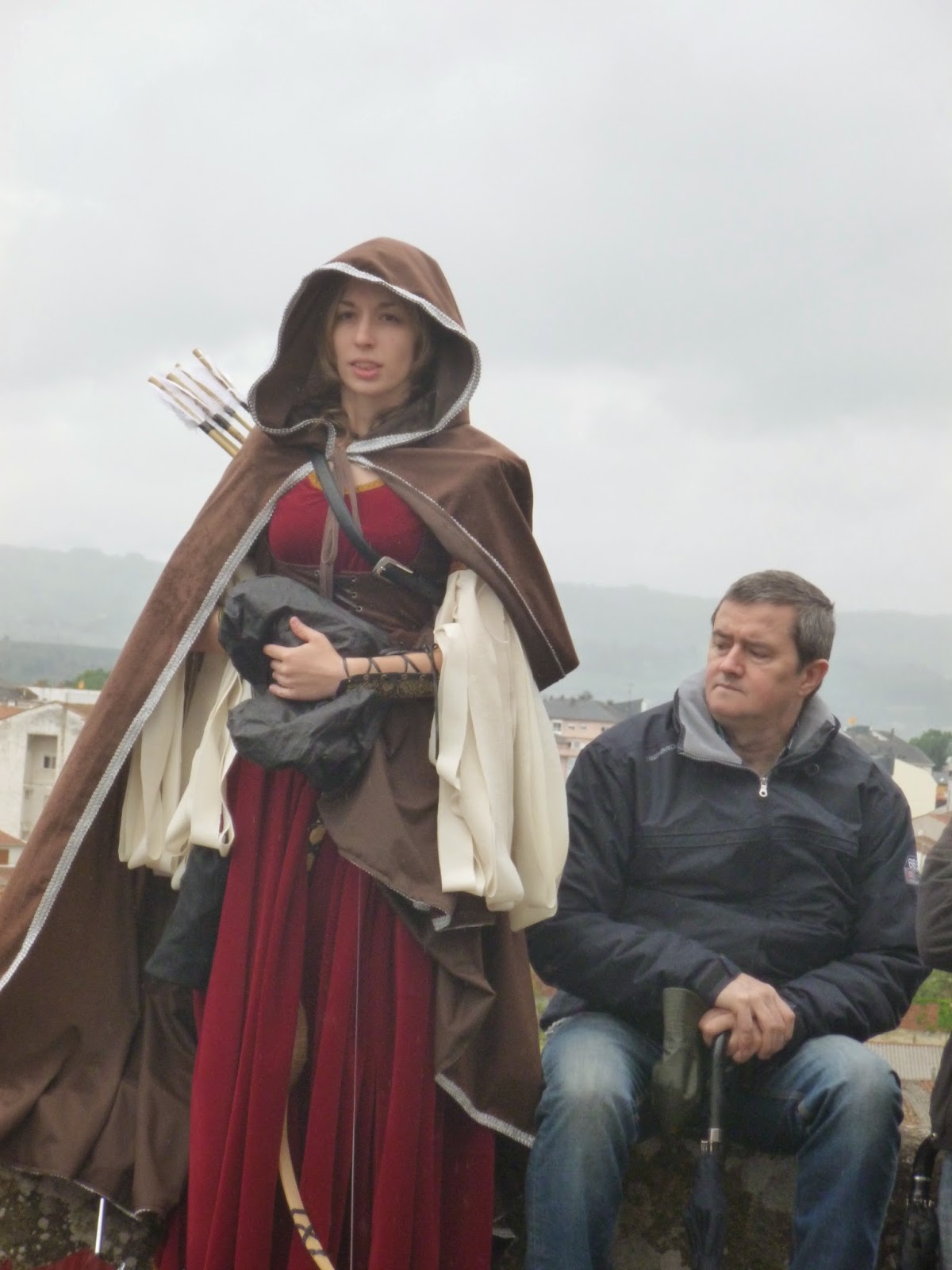 |
This woman was really into
her role. |
 |
The ever-present
witches. |
 |
I suppose this is where the knights
collected their helmets. |
 |
To defend their king and queen.
(Isabel and Ferdinand). |
 |
| King of Castile y Leon. |
Another feature of this festival each year that we particularly enjoy is the showing of the raptors -- hawks, falcons, owls, ravens . . . Two trainers have taught them to do tricks, and they are always fascinating to watch, not to mention what beautiful birds they are:
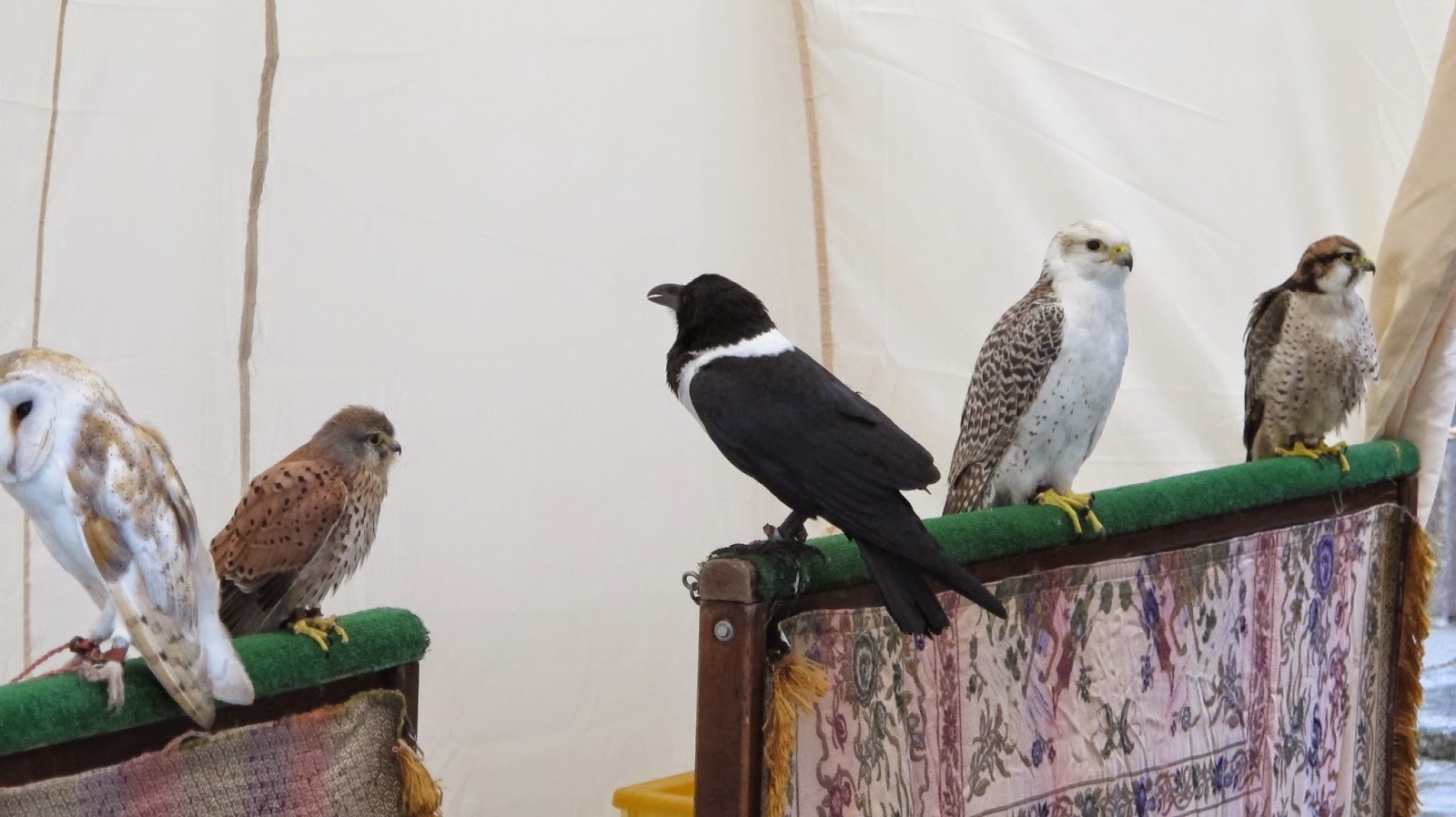 |
Such beautiful birds! I think they said
this unusual raven (with the white stripe) is distinctive to Galicia. |
 |
| The horned owl is so commanding! |
 |
But this hawk is pretty
impressive, too. |
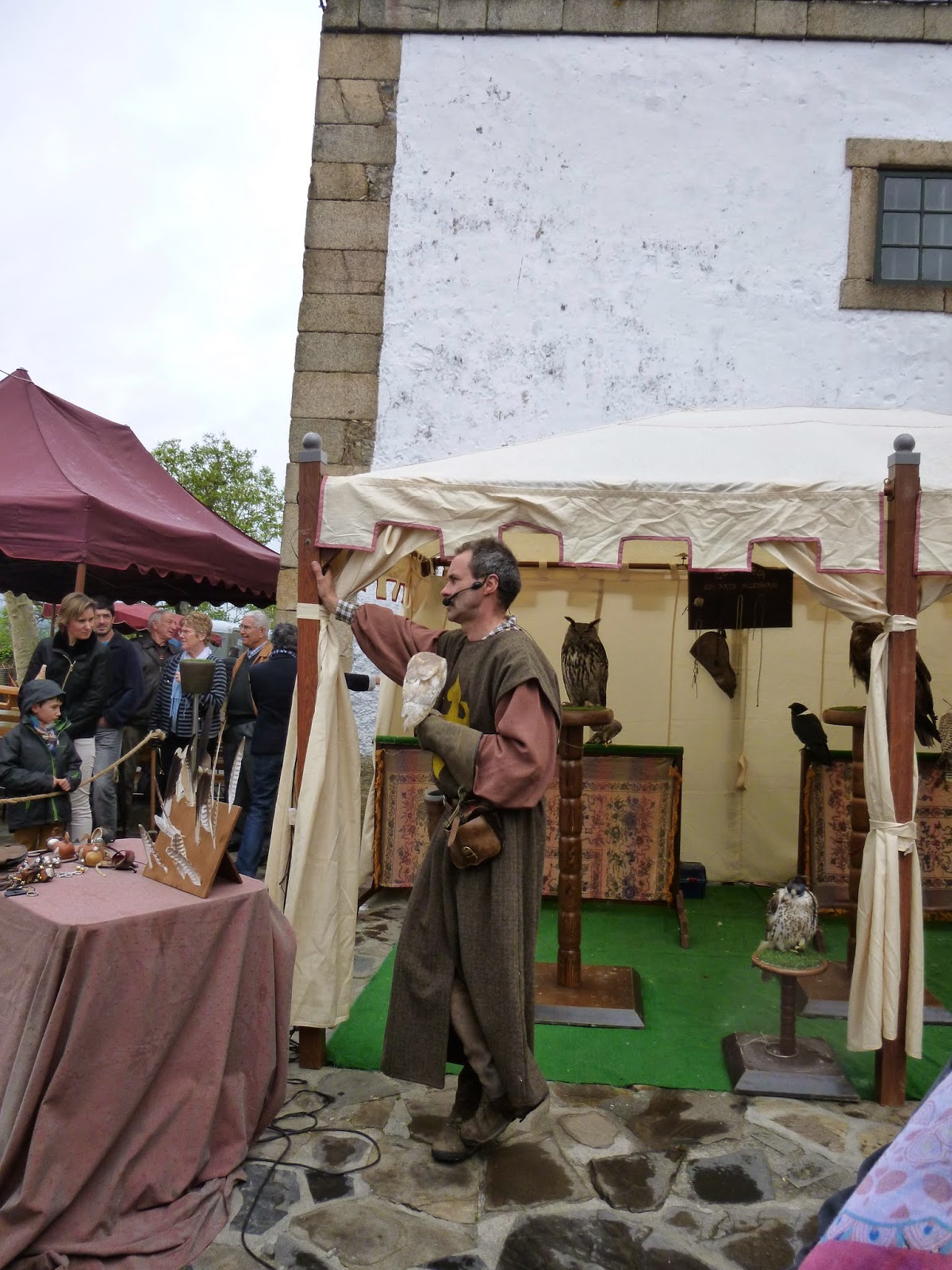 |
| One of the trainers and a snowy owl. |
 |
The other trainer watching
a falcon he released. |
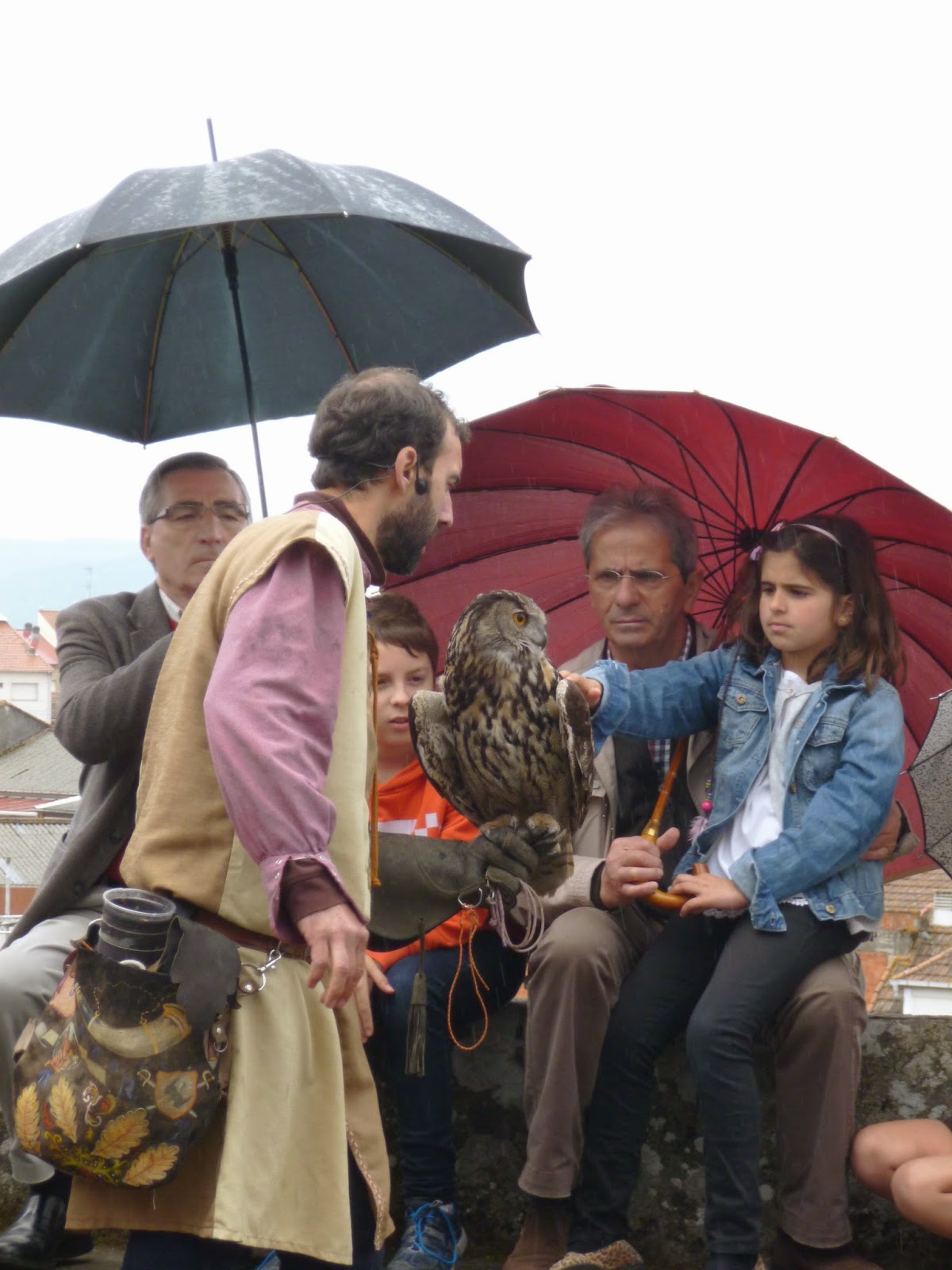 |
They finished off the show
with an interval when people
could pet one of the birds. |
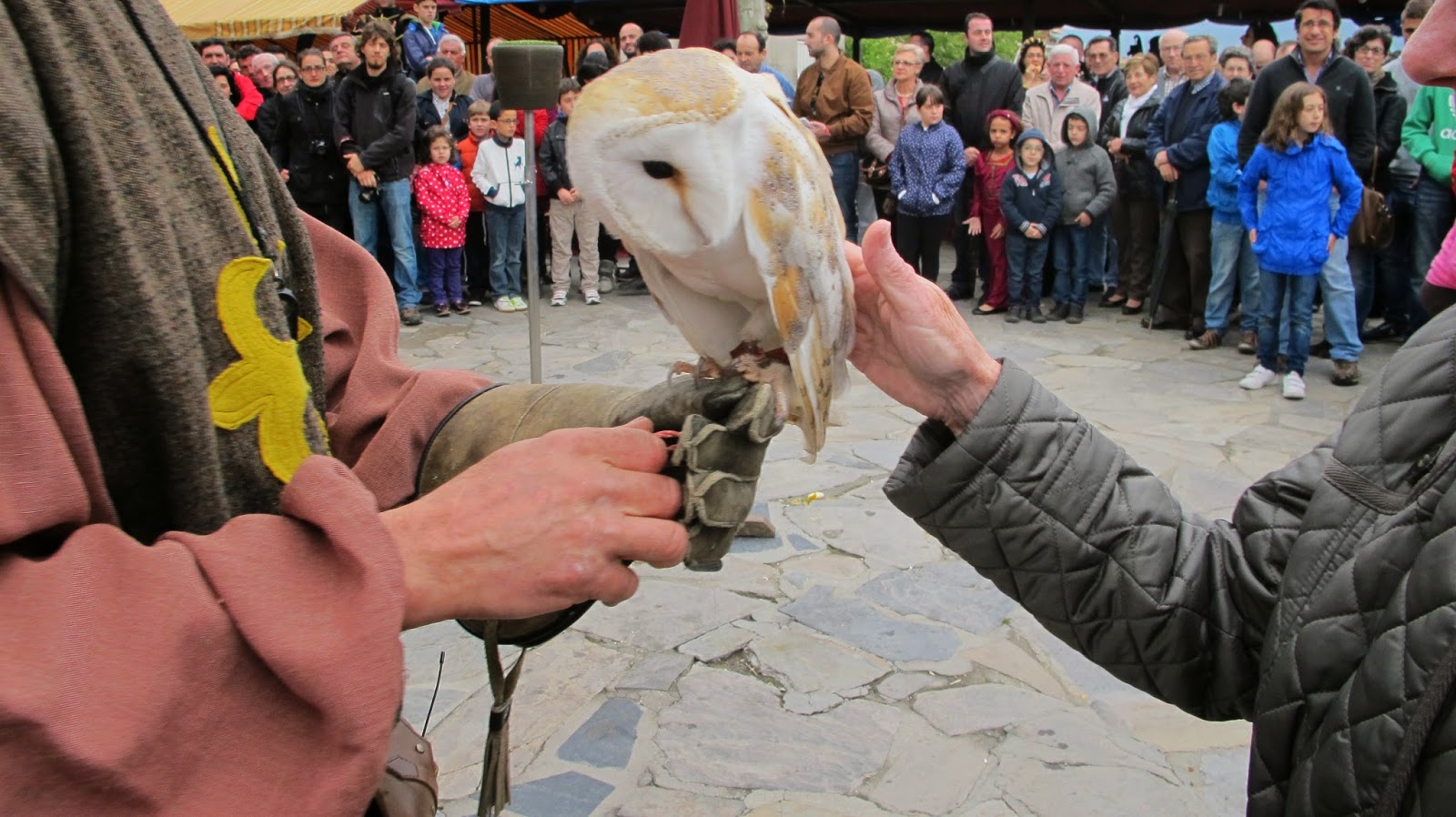 |
And who would you guess is petting that snowy owl?
Yup. Yours truly. It was really an awesome experience. |
So there you are: Two "local" events we thoroughly enjoyed. I hope you enjoyed them too.
How about you? Do you enjoy historical fairs and festivals? Have you ever petted a wild bird?

With blog problems these past few days, I'm behind in my posting. Last Friday was a fabulous evening at Torre Vilariño (a later post and photos will come), and we spent both Saturday and Sunday in Monforte enjoying the Medieval Faire (again, a later post and pictures will come).
First, though, I have to share a concert we attended in Quiroga by a fabulous fadista (Fado singer)— María do Ceo. She's very popular here and famous worldwide.
I first heard María do Ceo sing last June when she gave a concert at Rectoral de Castillon. At that time, I bought the CD shown to your left, and I blogged about it
HERE. It was an unforgettable evening, and my first exposure to Fado. (That was when Rajan and I we were taking turns with trips while the other nursed our ailing dog during his last days.) When I returned home and played the CD for Rajan, he loved Fado. Attending one of her concerts became a priority for this trip.
We went with friends Craig and Melanie, who hadn't heard Fado before, and they became converts, too. At the end of the concert, we gathered with others to get María do Ceo's autograph. She is a remarkable performer, and very down-to-earth and unpretentious after performances. Everyone was having their picture taken with her, and she welcomed us to have our picture with her too. What a treat!
 |
After a long concert, she
still had buoyant energy
as she signed autographs. |
 |
She took time to converse
with people who lingered.
A truly gracious person. |
 |
She remembered my name (from FB
and the early blogpost.) A very
modest celebrity who makes you
feel welcome and at home. |
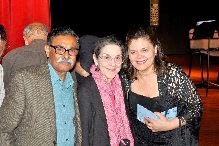 |
| I enjoyed introducing her and Rajan. |
 |
She was kept pretty
busy with autographs. |
You can go to her website and see her CD's
HERE.
We bought a new CD that we enjoy as much as the first one, and now I wish I had bought more. Each one is unique. The one we bought isn't shown in the Discography section on her website above. But there are many performances by her on YouTube at
this site, so you can get a feel for her singing.
Fado, as I mentioned in my earlier post, is a distinctive art form of Portugal, similar in one sense to American Blues, in that it is emotional and comes from deep in the heart and soul. But Fado has a variety of influences, one of them Moorish, and you can hear that in the warbling minor trills in some of the songs. The word itself means "Fate." Usually the songs are about deep yearning and thwarted dreams. Some of them can have a cheerful beat, but it's a fatalistic cheer, dealing with life's outcomes. It's not depressing, though. It's a response to what life deals you. I'm hooked on Fado, and if I can find another Fado concert, I will. Unfortunately, we will be gone before María do Ceo's next concerts in Galicia, but we will watch her schedule and hope to hear her during our next visit in the fall.
María do Ceo is from Portugal, but she lives in Ourense, Galicia. Her songs are in Portuguese, but her singing is quite popular all over Galicia.
Gallego, or
Galego, or
Galician—all are accepted names for the Galician language—is a sister language to Portuguese, so all her songs are understandable to Galicians. I read recently that Gallego and Portuguese share 85% of vocabulary. Our neighbors, in fact, have told us if we knew Portuguese, we would be able to understand Gallego.
Meanwhile, I hope you will visit her website and enjoy the video site
HERE. I strongly recommend "Lela" and "Negra Sombe". But, really, they are all good.
How about you? Do you have favorite music genre? A favorite singer? Please share.


By:
Elizabeth Varadan,
on 4/15/2014
Blog:
Elizabeth Varadan's Fourth Wish
(
Login to Add to MyJacketFlap)
JacketFlap tags:
Spain,
trip,
Santiago,
airports,
Galicia,
Toiriz,
storks,
bucket lists,
Camino,
nature walks,
Trasulfe,
Add a tag
It's hard to believe that we arrived in Spain 8 days ago. Time flows by in a different way, even though we bring work with us. The trip is long, we arrive exhausted, but we have rituals along the way. The trip is more than 24 hours (door to door) and spans two days. We leave Saturday morning, have a long stretch in Dallas/FW Airport, where we have battered and fried green beans and a glass of beer at TGIF, waiting for our next flight. We arrive in Madrid around 10:30 a.m. Sunday, and have a lunch of smoked salmon, bread, and wine, then fight sleep while waiting for our connection to Santiago de Composetela. We arrive in Santiago a little after 5:00 p.m. and collect baggage. Our friends, Terri and David, meet us, drive us back to our house in Trasulfe, where we "turn on the house" (electricity, water, gas-tank connections, etc.), then we all go out to eat at a restaurant in Monforte, called O Pincho, where we split delicious raciones. (Rations are smaller than dinners, bigger than tapas.)
Here's a picture of Terri and David from last summer (we haven't yet gotten around to pictures of friends on this trip.) As soon as we got to O Pincho, we woke up and had a great time catching up on news, eating rations and drinking the house wine. The next morning, waking with the sun (about seven-ish), eating lunch at 2:00 p.m. and dinner around 8:00 or 9:00 p.m., Rajan and I realized we'd fallen into Spanish time right away, with very little jet lag!
Friends and neighbors tell us it was a continually rainy winter, but our first few days were sunny. There was the usual morning mist and intermittent sprinkles through the day that vanished in afternoon heat. Still, we felt free to bring out our patio table and chairs. Then things changed.
 |
The small pasture across the sheep
path in front of our gate. The thin
tree in the foreground is a volunteer
peach tree that so far doesn't bear. |
 |
A neighbor's pasture below ours.
See those little fruit trees? The storm
blew all the petals away. No fruit
this year. |
After four beautiful sunshiny days, on Thursday afternoon a fierce hailstorm struck. First thunder rolled and roared for about an hour, and then hail beat down for about thirty minutes. This was the result :
 |
| These aren't snow drifts. Just lots and lots of hail. |
I wanted to put a video here, with all its great sound effects, but I couldn't get my video to play. (I've sent to Google for help.) But this should give you some idea.
On another note, we've been making a point to walk at least two miles a day. In about a year, I want to walk a portion of the Camino that ends in Santiago. (One item on my bucket list.) I won't be able to make it to Santiago, but a friend informed me that if you walk 100 km, you can get a certificate. That's about sixty miles. Next spring I'd like to do about 30 miles, and then in the fall of 2015 do the second set. So far, a few times we've parked at Gadis, one of the big supermarkets at the edge of Monforte, and walked up to the Parador.
 |
Here's the Parador, seen from the Gadis parking lot.
Below is Gadis, seen from Parador, to give you and
idea of how far we walk. |
 |
Gadis, where we parked, seen from the Parador: See the thin pale blue
stripe about two thirds up in the middle? Above the center green? To the
left of that is a teeny yellow sign. That's Gadis.
Other walks have been along country roads. Beautiful nature walks, really. This will give you some
idea: The picture on the left is an example of most of the scenery here.
The picture to the right is of a pretty church in Toiriz. We don't have pictures yet of the stork nests, but on tall posts nearby, there are two separate stork nests, and we sometimes see one of the parent birds feeding the baby birds. All you can see is the upended body, so we aren't quite sure how big those babies get. Hopefully we'll get a good photo sometime soon.
And now, it's time for a walk! But stay tuned, because the next post will be about a wonderful Fado singer we heard Sunday night.
Meanwhile, if you have special items on your bucket list, I'd love to hear what they are.
|

By the time you read this, we will be on our way to Galicia, Spain, to the village and the people that have stolen our hearts. It's a long trip. But stay tuned. I'll be posting about our new ventures soon.

By:
Elizabeth Varadan,
on 10/6/2012
Blog:
Elizabeth Varadan's Fourth Wish
(
Login to Add to MyJacketFlap)
JacketFlap tags:
Spain,
bands,
bagpipes,
Galicia,
fiesta,
Monforte,
San Froilan,
organs,
Lugo,
orchestras,
castanets,
harps,
travel,
Add a tag
Here we are, still in our first week, and it has felt jam-packed. We arrived Monday evening, late. It was midnight before we got to bed. Then we spent the first couple of days opening the house, vacuuming and dusting, etc., and unpacking. Thursday we met friends in town at our favorite café bar in Monforte, Adega do Carlos, and yesterday we went to Lugo and stayed overnight for the San Froilán Fiesta.
The festival actually goes on for eight days, and yesterday, Friday, was the major religious day as San Froilán is the patron saint of Lugo, and the second day was the actual saint's day. Lugo is an ancient city about 60 miles north of Monforte, and it has both a Roman and Celtic past. (Well, for that matter, you can say that of all of Galicia: a Roman and Celtic past. There are old Roman bridges with arches everywhere, and the culture is both castiliano and galegan .)
What's fascinating about Lugo is that the center of town—the original town—is enclosed in a circular wall with about 17 arched entrances; a wall so thick it's wide enough for a car to drive atop, although only walking is permitted. Inside the walls are the old crooked cobbled streets, replete with restaurants and café bars, as well as two cathedrals and several plazas. Once we drove in and found the closest parking garage to our hotel, we unpacked and headed out to stroll the plazas and listen to music. Because it was the saint's day, all the clothing shops, etc., were closed, although eateries and bakeries were open.
Around the Plaza Mayor two huge stages were in preparation for the evening orchestra/bands. But the ayuntamiento (council building) flanks one side of the Plaza Mayor, and the municipal orchestra of Lugo was playing excerpts from Tschaikovky's Swan Lake, as well as music by Rodrigo and other composers. Really lovely to listen to. Walking down one of the narrow streets, waiting for lunch time (2:00 p.m.), we heard strains by Mozart floating from a restaurant's open doorway.
We are vegetarians, so sometimes it's hard to find restaurant food in Spain, but, luckily we eat fish and seafood. So we had a really tasty lunch of croquetas bacalao (codfish), grilled prawns, and—a real adventurous "first" for us—steamed cockles with lemon. My goodness, they were good. They looked to me like tiny versions of clams, and they had that "ocean" flavor that was quite evocative. Along with wine, of course.
After lunch, wandering around, we found a band in rehearsal at the Plaza Santa Maria. They were playing all the traditional Galician music with traditional instruments. Their orchestra was composed of four harps, four bagpipes, four violins, six tambourines, one huge set of drums and a smaller drum, and about eight "lap" organs with handles, as well as castanets and a mouth instrument that was "twanged". The music was haunting and beautiful, and sometimes sounded Irish, and sometimes sounded Greek, and sometimes sounded Spanish. Just fantastic. Later, around nine p.m., after a picnic dinner in our room, we heard the concert all over again and enjoyed it just as much. Then, at 10:30 p.m. we returned to the Plaza Mayor to listen to another Latin orchestra. We sat and enjoyed that until nearly midnight, and then returned to the hotel and went to bed.
After rolls and coffee at a bakery this morning, we walked along the shopping areas (and I did find a nice belt and scarf.) We returned, then, to the "artesian" tent, where local artisans were showing their beautiful handicrafts. And then we headed back "home" around noon.
Weather-wise, we have been lucky. Except for rain this morning, and not a heavy one, it's another beautiful sunny day. And now, I must wrap this up. I'm at a wi-fi café, and I want to post this before we return to the house. Later, I'll try to post some pictures.
Meanwhile, for us, Galicia is a magical place. I write poetry about it at times. Before we started coming here, McKinley Park in Sacramento used to affect me that way. Do you have a place like that? If so, where?
Even though I am working on my rewrite like mad, I am taking time out to share my husband's wonderful photography exhibit in Galicia. Our friends, Terri and David Anderson set it up with the mayor of Ferreira, a small town near our village. The sneak preview was this week-end but it's really for the wine festival which begins June 2nd.
They did an awesome job of setting it up, and I hope you will go take a peek at the album I set up on Facebook on my timeline: here is my FB Timeline site. When you go there, just click on "Photos".(It's the first album. You'll recognize the cover picture.)
Sooo. . . , back to work now! See you in a couple of weeks.

By:
Elizabeth Varadan,
on 4/9/2012
Blog:
Elizabeth Varadan's Fourth Wish
(
Login to Add to MyJacketFlap)
JacketFlap tags:
book review,
Spain,
MG,
Galicia,
lucky 7 meme,
house sitter,
ciao,
dog sitter,
adios,
Add a tag
 |
| The Puente Roman in Monforte de Lemos |
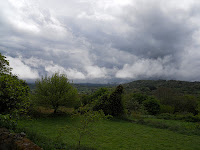 |
| A view from our galería window in Trasulfe |
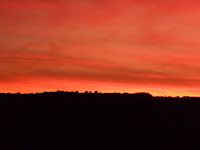 |
| Nightfall in Tasulfe |
Wednesday we will be on our way to Galicia, Spain, for four weeks. Four weeks that will be almost entirely in Spanish, except when we are with our British friends. Does this mean that we are fluent in Spanish? No. It means our Spanish friends are supportive and kind as we thumb madly through our pocket dictionaries to figure out what they just said. But we love the experience. And our Spanish is getting better.
So, I probably will not be blogging before Sunday. But please check back, because I have lots to share:
A review of Richard Hughes' story collection, Only the Lonely. (And my apologies, Richard, for putting your last name as Hansen in my last post when I passed out the Lucky 7 Meme. I have another friend named Hansen, and that just leaps out every time. I've made the correction in the post. And anyone reading this today, go check out his cool blog here. . . .)
A review of a book by Lewis Buzbee (title withheld to keep you wondering.)
A sprinkle of posts about Galicia.
14 Comments on Almost Off to Spain, last added: 4/13/2012
We left Sacramento Sunday morning, and already the week is drifting by. How can Saturday have come so soon?
It’s a long flight from Sacramento to Santiago. We changed at Dallas and again at Madrid, with generous wait times between flights to make sure any delayed flight would not make us miss the next. Our friends met us in Santiago. By the time we picked up our baggage, it was 6:30 in the evening. They drove us to Monforte, a drive of about an hour and a half, where we shopped for basic groceries. Then we all had dinner around 8:30 at a cafe-bar-restaurant called O Pincho. (Dinner at 8:30 or later . . . . That’s when you know you are in Spain.)
After trudging through airports and lugging carry-ons around for close to 26 hours, we practically fell into bed Monday night and had a good long sleep. One of our last, I might add, because jet lag kicked in the next day and is only starting to fade: we become sleepy or wide awake at very odd hours.
It’s wonderful to be here, taking short walks with our neighbors in the village, driving into Escairon for café con leche, or into Monforte to sit at an outdoor table in the big plaza, enjoying a glass of wine. Or going to Adega do Carlos for raciones at lunchtime (which is between 2:00 and 4:00 p.m. in these parts.) Or meeting our neighbors again, late in the day, at the bench down the lane, sitting and talking with them until clouds turn pink and the air turns suddenly cool. Already these lovely friends have loaded us up with potatoes, figs, tomatoes, peppers, and home-made wine. In addition, we’ve been setting up lunch and dinner dates with friends we haven’t seen since our last trip, and tomorrow night is the Fiesta in Tuiriz (a village/town within walking distance, although we will drive, since we won’t go until around 9:30 or so.)
9 Comments on We’re Here in the Land of Mist and Mañana, last added: 9/26/2011






























Have safe travels, and can't wait to hear of your adventures! :)
Have a great time. I look forward to reading your writings and seeing Rajan's wonderful photos.
Have a safe trip, Elizabeth.
I look forward to your exciting posts.
Have a safe trip and enjoy yourselves.
Looking forward to reading and viewing photos from the adventure!
I can't wait! I love your blog posts about your travels. Have fun, Elizabeth!
Safe and wonderful travels to you!! Galicia, Spain, sounds wonderful. Enjoy!! and we'll look forward to hearing about your trip.